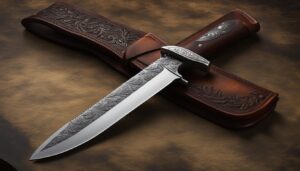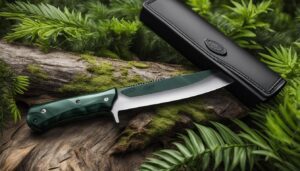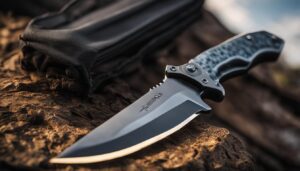Hunting is an art that requires precision, skill, and the right tools. One essential tool every hunter should have is a hunting knife. But with so many options available, how do you determine the ideal weight for a hunting knife? In this article, I will explore the importance of finding the perfect balance and weight for your hunting knife to ensure a seamless hunting experience.
When it comes to hunting knives, you have a variety of weight options to choose from. But finding the best weight for your hunting knife depends on several factors, including the type of game you plan to hunt and how you will use the knife. Whether you opt for a fixed blade or a folding knife, it’s crucial to find the right balance between weight and functionality.
A well-balanced hunting knife offers greater control and maneuverability, reducing strain and fatigue during prolonged use. It also contributes to the stability and accuracy of your cutting motions, ensuring efficient and precise cuts. Moreover, the weight of your hunting knife should be comfortable to hold and maneuver, allowing you to perform tasks with ease.
Key Takeaways:
- Consider the type of game you plan to hunt and the tasks you will perform when choosing the weight of your hunting knife.
- A well-balanced hunting knife offers better control, maneuverability, and stability, reducing hand fatigue during use.
- Different knife types may require varying balances based on their intended use, so understanding your specific needs is essential.
- Finding the ideal hunting knife weight is subjective, influenced by personal preferences and the desired hunting experience.
- Take care of your hunting knife and invest in a set of knives and related tools to adapt to different hunting situations.
Factors to Consider in Knife Selection: Control, Maneuverability, and Stability
When choosing a hunting knife, it is essential to consider factors such as control, maneuverability, and stability. These aspects play a significant role in determining the overall performance and usability of the knife, as well as reducing strain and fatigue during use.
The balance of a knife is crucial in achieving optimal control and maneuverability. A well-balanced knife allows for precise movements and reduces hand fatigue, making it easier to handle during prolonged use. It also contributes to the overall stability of the knife, minimizing the risk of accidents or mishaps.
Proper balance ensures that the force applied to the knife is evenly distributed along the blade, enhancing cutting efficiency and reducing strain on the user. Different types of knives may require varying balances based on their intended use. For example, a knife with a slight forward balance is ideal for rocking motions, while a knife with a more rearward balance offers greater precision.
| Factors to Consider | Benefits |
|---|---|
| Control | Allows for precise movements during hunting tasks |
| Maneuverability | Reduces hand fatigue and enhances overall usability |
| Stability | Minimizes the risk of accidents or mishaps |
To determine the balance of a knife, it is helpful to hold it and assess how it feels in your hand. A well-balanced knife should feel evenly distributed or slightly tip-heavy, depending on the type of knife. Finding the right balance is a combination of general guidelines and personal preference, ensuring that the knife feels comfortable and easy to control.
By considering factors such as control, maneuverability, and stability, you can choose a hunting knife that provides reduced strain and fatigue during use. The right balance is key to enhancing your hunting experience and ensuring optimal performance in the field.
The Impact of Balance on Cutting Efficiency and Knife Design
When it comes to the performance of a knife, balance plays a crucial role. The balance of a knife directly affects its cutting efficiency, functionality, and overall usability. A well-balanced knife allows for smooth, precise cutting motions, making it easier and more comfortable to use. By distributing the force applied along the blade evenly, proper balance ensures efficient cutting, reducing the strain and fatigue on the user’s hand.
Different knife types may require varying balances to optimize their intended use. For example, a chef’s knife benefits from a slight forward balance, which facilitates rocking motions and enhances chopping and slicing. On the other hand, a fillet knife may have a more rearward balance, providing greater precision and control for delicate tasks like deboning fish.
Designers and manufacturers take the impact of balance on functionality into consideration when creating knives. They carefully determine the weight distribution and handle design to achieve the desired balance for specific knife types. Achieving the perfect balance involves a combination of general guidelines and personal preference, as it can vary depending on factors such as the length and width of the blade, the type of cutting motion required, and the user’s hand size and strength.
Knife Balances at a Glance:
| Knife Type | Ideal Balance |
|---|---|
| Chef’s Knife | Slight forward balance for rocking motions |
| Fillet Knife | More rearward balance for precision and control |
| Boning Knife | Neutral balance for versatility and maneuverability |
| Bread Knife | Forward balance for better control when cutting through crusts |
Understanding the impact of balance on cutting efficiency is essential for selecting the right knife for specific tasks. Whether you’re a professional chef or an avid home cook, finding the right balance in your knife will not only improve your cutting experience but also enhance your overall culinary skills.
Choosing the Ideal Hunting Knife Weight: Factors to Consider
When selecting a hunting knife, finding the ideal weight is crucial for a successful and comfortable hunting experience. Several factors should be taken into consideration to ensure that the chosen knife weight is optimal for your needs.
First and foremost, the weight of the knife should be comfortable to hold and maneuver during hunting tasks. A knife that is too heavy can cause fatigue and strain, making it difficult to perform precise and controlled movements. On the other hand, a knife that is too light may lack the necessary strength and stability for certain hunting tasks.
Personal preference also plays a role in determining the ideal hunting knife weight. Some hunters may prefer a heavier knife for added power and durability, while others may opt for a lighter knife for ease of use and agility. It is essential to find a balance that suits your individual preferences and hunting style.
In addition to personal preference, the type of game being hunted can also influence the ideal knife weight. For larger game, a slightly heavier knife may be preferred to handle the tougher skin and bone. Conversely, a lighter knife may be more suitable for smaller game that requires precision cutting.
By carefully considering these factors and finding the right balance between weight, functionality, and user comfort, you can choose the ideal hunting knife weight for a seamless and enjoyable hunting experience.
Table: Comparison of Hunting Knife Weights
| Knife Type | Weight Range (ounces) |
|---|---|
| Folding Knife | 2-5 |
| Fixed Blade Knife | 4-10 |
| Skinning Knife | 3-7 |
| Boning Knife | 3-6 |
This table provides a general comparison of hunting knife weights based on different knife types. It is important to note that these weight ranges can vary depending on the specific knife model and brand. Consider this table as a starting point to understand the weight options available for each knife type.
Remember, the ideal hunting knife weight is a personal choice, and what works for one hunter may not work for another. It is recommended to visit a local hunting gear store and physically handle different knives to determine the weight that feels most comfortable and suitable for your hunting needs.
By selecting the ideal hunting knife weight, you can enhance your hunting skills, ensure optimal performance, and enjoy a successful hunting trip.
Conclusion
In conclusion, choosing the ideal hunting knife weight is a subjective decision that depends on various factors. Understanding the type of game you plan to hunt, the tasks you will perform, and your personal preferences is crucial in finding the perfect balance.
When selecting a hunting knife, it is important to consider its functionality, balance, and user comfort. A knife that is too heavy can lead to fatigue and difficulty in performing precise tasks, while a knife that is too light may lack the necessary strength and control.
By considering the factors discussed in this article, such as the type of knife, blade material, and overall balance, you can make an informed decision about the ideal hunting knife weight for your needs. Additionally, taking proper care of your knife and investing in a set of hunting knives and related tools will ensure that you are prepared for various hunting situations.
With the right hunting knife weight, you can enhance your skills, enjoy a seamless hunting experience, and increase your chances of a successful hunting trip.
FAQ
What are the different types of hunting knives?
Hunting knives can be fixed blade or folding, with various blade types such as clip point, drop point, and skinning blades.
What is the difference between carbon steel and stainless steel blades?
Carbon steel blades are known for their sharpness and ease of sharpening, while stainless steel blades are resistant to rust and corrosion.
How should I care for my hunting knife?
Proper care includes storing the knife correctly and regularly sharpening it to ensure optimal performance and longevity.
Why is balance important in a hunting knife?
Balance affects control, maneuverability, and cutting efficiency, leading to better user comfort and reducing hand fatigue.
How do I test the balance of a knife?
You can check if a knife feels evenly balanced or tip-heavy by holding it and assessing its weight distribution.
Does the balance of a knife affect its cutting efficiency?
Yes, a well-balanced knife enables smooth and efficient cutting motions, making it easier to use and enhancing its overall functionality.
Which factors should I consider when choosing the weight of a hunting knife?
Factors to consider include comfort, maneuverability, the type of game being hunted, and the specific tasks that the knife will be used for.
What is the ideal hunting knife weight?
The ideal hunting knife weight is subjective and depends on individual preferences, the type of game being hunted, and the tasks to be performed.





